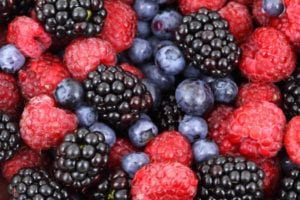Written by Joyce Smith, BS. Twenty years of consuming small amounts of flavonoid rich foods such as apples, berries and tea doubled and even quadrupled the risk of developing Alzheimer’s disease (AD) and Alzheimer’s disease related dementias (ADRD) compared to consuming higher amounts of flavonoid rich foods.
 The United States Census Bureau predicts that by 2034, 77 million Americans will be 65 years of age and older compared to 76.5 million Americans under the age of 18. With the increase in seniors comes an increase in AD and ADRD and their accompanying challenges. By 2051, 14 million people are projected to have AD. The absence of effective pharmaceutical interventions has spurred an interest in modifiable and natural risk factors such as diet 1,2 , particularly a diet that is rich in flavonoid- containing fruits and vegetables 3,4. Common sources of flavonoids include anthocyanin-rich berries and red wine, flavonol-rich onions and apples, flavanone-rich citrus fruits and juices, and flavan-3-ol-rich teas and dark chocolate 5.The present observational study by Shishtar et al explores a potential association between the risk of ADRD and long-term consumption of dietary flavonoids commonly consumed in Western diets. 6
The United States Census Bureau predicts that by 2034, 77 million Americans will be 65 years of age and older compared to 76.5 million Americans under the age of 18. With the increase in seniors comes an increase in AD and ADRD and their accompanying challenges. By 2051, 14 million people are projected to have AD. The absence of effective pharmaceutical interventions has spurred an interest in modifiable and natural risk factors such as diet 1,2 , particularly a diet that is rich in flavonoid- containing fruits and vegetables 3,4. Common sources of flavonoids include anthocyanin-rich berries and red wine, flavonol-rich onions and apples, flavanone-rich citrus fruits and juices, and flavan-3-ol-rich teas and dark chocolate 5.The present observational study by Shishtar et al explores a potential association between the risk of ADRD and long-term consumption of dietary flavonoids commonly consumed in Western diets. 6
A total of 2,800 participants aged 50 and older, who were AD and ADRD free, filled out dietary questionnaires (to assess dietary flavonoid intake) at a baseline medical exam and at subsequent four-year medical exams for a total of five exams.
The researchers categorized flavonoids into six types and created four intake levels based on percentiles: less than or equal to the 15th percentile, 15th-30th percentile, 30th-60th percentile, and greater than 60th percentile.
- Low intake (15th percentile or lower) was equal to roughly one-and-a-half apples (flavonols) per month, and no berries (anthocyanins) or tea (flavonoid polymers) per month.
- High intake (60th percentile or higher) was equal to roughly 7.5 cups of blueberries or strawberries (anthocyanins) per month, 8 apples and pears (flavonols) per month, and 19 cups of tea (flavonoid polymers) per month .
The six types of flavonoids were analyzed and the long-term intake levels were compared to the number of AD and ADRD diagnoses. The researchers found that during an average follow-up of 19.7 years, there were 193 ADRD events, of which 158 were Alzheimer’s disease. Individuals with the lowest intakes (≤15th percentile) of three flavonoid types (flavonols, anthocyanins, flavonoid polymers) had a higher risk for ADRD versus individuals with the highest intakes (>60th percentile) in an adjusted analysis (hazard ratios: flavonols, 0.54; anthocyanins, 0.24; flavonoid polymers, 0.58). Thus, low flavonol and flavonoid polymer intakes (apples, pears and tea) were associated with twice the risk of developing ADRDs and low anthocyanin intake (blueberries, strawberries and red wine) was associated with a four-fold risk of developing ADRD. The results were similar for AD for two of the three flavonoid types (flavonols and anthocyanins , but not for flavonoid polymers). These findings suggest that diet may be an important contributor to ADRD and AD risk in US adults. Larger studies with more racially and ethnically diverse participants are recommended.
Study limitations included the recall errors of self-reported food questionnaires, the use of only adults of European decent which limits generalizability, and the fact that the study does not prove a causal relationship between flavonoid intake and development AD and ADRD.
Source: Shishtar, Esra, Gail T. Rogers, Jeffrey B. Blumberg, Rhoda Au, and Paul F. Jacques. “Long-term dietary flavonoid intake and risk of Alzheimer disease and related dementias in the Framingham Offspring Cohort.” The American Journal of Clinical Nutrition (2020).
© The Author(s) Open Access licensed under Creative Commons Attribution Non-Commercial License (http://creativecommons.org/licenses/by-nc/4.0/)
Click here to read the full text study.
Posted May 18, 2020.
Joyce Smith, BS, is a degreed laboratory technologist. She received her bachelor of arts with a major in Chemistry and a minor in Biology from the University of Saskatchewan and her internship through the University of Saskatchewan College of Medicine and the Royal University Hospital in Saskatoon, Saskatchewan. She currently resides in Bloomingdale, IL.
References:
- Rakesh G, Szabo ST, Alexopoulos GS, Zannas AS. Strategies for dementia prevention: latest evidence and implications. Therapeutic advances in chronic disease. 2017;8(8-9):121-136.
- Hu N, Yu JT, Tan L, Wang YL, Sun L, Tan L. Nutrition and the risk of Alzheimer’s disease. Biomed Res Int. 2013;2013:524820.
- Berti V, Walters M, Sterling J, et al. Mediterranean diet and 3-year Alzheimer brain biomarker changes in middle-aged adults. Neurology. 2018;90(20):e1789-e1798.
- Valls-Pedret C, Lamuela-Raventós RM, Medina-Remón A, et al. Polyphenol-rich foods in the Mediterranean diet are associated with better cognitive function in elderly subjects at high cardiovascular risk. Journal of Alzheimer’s disease : JAD. 2012;29(4):773-782.
- Bai W, Wang C, Ren C. Intakes of total and individual flavonoids by US adults. International journal of food sciences and nutrition. 2014;65(1):9-20.
- Shishtar E, Rogers GT, Blumberg JB, Au R, Jacques PF. Long-term dietary flavonoid intake and risk of Alzheimer disease and related dementias in the Framingham Offspring Cohort. Am J Clin Nutr. 2020.
